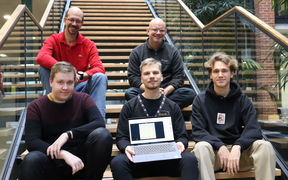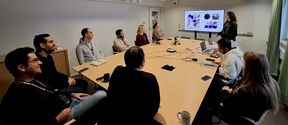Students coded an open-source microprocessor that companies can use as they wish

In September, the President of the European Commission, Ursula von der Leyen, called on Europe to take action to strengthen the European semiconductor industry. Semiconductors include microprocessors, which are needed in almost all technologies today, from remote controls to cars and airplanes.
Earlier in the summer, a group of Aalto University microelectronics students implemented a hardware description of a RISC-V microprocessor by coding it and have now published it openly online. The work is based on the open-source RISC-V processor architecture developed at the University of Berkeley, says Marko Kosunen, who also worked at Berkeley and supervised the students' work.
“A team of four technical students coded it during the summer. Now the processor is at a stage where it could be manufactured.”
Coding and verifying the processor was a great summer job, say Julius Helander, Leo Uusimäki and Otto Simola.
“It's hard to imagine a better outcome: Concrete design, and the code will live on in the future as part of the project.”
Verneri Hirvonen, who has done a bachelor's thesis on the subject, agrees.
“The development of the processor and the construction of its verification environment provides the students an opportunity to use of the skills we’ve acquired in the early stages of our studies in programming and electronics.”
From closed to open
The rise of Nokia's mobile phones in the 1990s was based on strong microelectronics expertise, which was built in, among other places, the Helsinki University of Technology's circuit technology laboratory. Although the manufacturing of microelectronics and processors - and later telephones - was abandoned, much of the know-how related to the field remained in Finland.
Currently, the design and manufacture of the microprocessors needed by the world is firmly in the possession of the large American and Asian corporate giants. Processors are mainly closed and patented systems, which means that companies that buy and use them do not have the opportunity to make changes to them.
“If someone decides to do so and succeeds, they will probably infringe the patent and license, and will be responsible for it in court,” says Kosunen.
The operation of the microprocessor is controlled by an instruction set. It is a technical document that defines how a microprocessor should respond to instructions passed to it. The instruction sets of large manufacturers such as Intel and ARM are encrypted. The RISC-V instruction set, coded by Aalto students, is open, accessible to everyone and designed to be modified and expanded to suit their own needs. Kosunen emphasises that this is only a single-core processor. For example, in artificial intelligence applications, there can be tens or hundreds of cores. However, the advantage of an open processor is the flexibility that allows Aalto's processor to work in different environments.
“It will work on accelerators for encryption algorithms and signal processing, network devices, 6G and then 7G transceivers,” Kosunen says.
“Basically, it can control anything.”
High demand in the industry
The idea of designing our own microprocessor arose a year and a half ago at a meeting between Jussi Ryynänen, professor of microelectronics design, and representatives from Nokia. There is a growing need for processor design expertise, and interest in processor development in an open environment. In addition to Nokia, the project involves Saab, CoreHW, Xiphera and Minima Processor, and is partly funded by Business Finland.
“Our goal is to train Finland's best designers in analogue, digital and hybrid microelectronics systems and to include processor design as part of doctoral training in microelectronics,” says Ryynänen, who emphasises that this is a strategic area for Finland and Europe.
“Without our own design expertise, we are at the mercy of what microelectronics manufacturers in the United States and Taiwan offer us.”
More information:
Professor Jussi Ryynänen, Aalto University
tel +358 50 384 1720
jussi.ryynanen@aalto.fi
Senior University Lecturer Marko Kosunen
tel +358 50 375 1711
marko.kosunen@aalto.fi

Aalto's students' hardware description is like a software manufacturing guide for a microprocessor, which companies or other users can modify to their own needs and then manufacture themselves or leave the manufacturing to others.
Source code version control at https://gitlab.com/a-core.
Read more news

Floriane presents research findings on denim recycling
On 15 January 2026, Floriane Jacquin, an intern with the Textile Chemistry Group at Aalto University, presented the findings.
Postdoctoral researcher Eloi Moliner makes history as a 5-time award winner
Eloi Moliner is one of the most decorated doctoral researchers in Aalto University's history – we would like to highlight his success and contributions to the field of audio signal processing
2 million euro donation to Aalto University's new multidisciplinary Bachelor’s programme – Donors: Matti Alahuhta, Sari Baldauf, Antti Herlin, and Jorma Ollila
Set to launch in autumn 2027, the multidisciplinary Bachelor's programme combines technology, business, arts, and design






